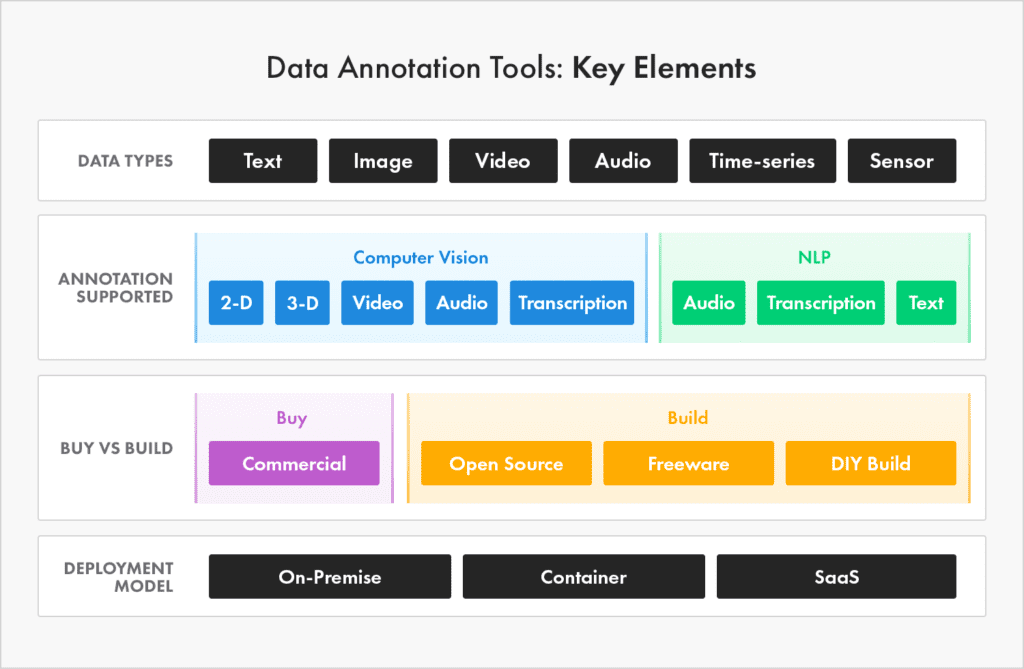You’ve collected a lot of raw data, and now you want to feed that data into artificial intelligence (AI) systems so they can perform human-like activities. The problem is that these machines can only operate according to the parameters you define for your dataset. The way to bridge the gap between sample data and AI/ML is data labeling
Human data annotators go into raw data collections and generate categories, labels, and other descriptive components so machines can interpret and act on the information.
Annotated raw data used in artificial intelligence and machine learning typically consists of numeric data and alphabetic text, but data annotation can also be applied to photographs and audio/visual elements.

What is Data Highlighter?
A data labeler is a software solution that emphasizes building training data for machine learning. It can be cloud-based, on-premises or containerized. On the other hand, some companies prefer to build their tools. There are various open source or shareware data labeling options available.
They are also available for lease and purchase. Data annotation tools are typically designed to work with some form of data, such as image, video, text, audio, spreadsheet, or sensor data, and they offer many deployment strategies.
The 5 major functions of the data annotation tool:
Annotation tools are critical to the overall effectiveness of the annotation process. They help with speed and production quality, but they also help with enterprise management and security.
Since various tools save annotation output in a variety of ways, you must ensure that the tool can meet your team’s output needs. Also, because of where the data is stored, you must verify that the file storage destination is supported.
Another factor to consider when developing dataset management is the tool’s ability to share and connect. In particular labeling and AI data processing is sometimes done using offshore organizations and requires fast access and connection to datasets.
2. Marking method:
The technique and functionality of applying labels to data is known as an important aspect of data annotation tools. Depending on your current and projected future needs, you may wish to focus on specialists or use a more comprehensive platform.
Building and managing vocabularies or guidelines, such as label maps, classes, attributes, and specific labeling categories, are typical labeling functions provided by Data Labelers.
Furthermore, automation or automatic labeling is a new feature in many data labeling techniques. Many AI-driven solutions will help your annotators improve their labeling capabilities and even automatically label your data without human intervention.
Several techniques can learn from the activities of human annotators to improve the reliability of automatic labeling. If you label photos with pre-annotation, the data labeling team can decide whether to enlarge or eliminate the bounding box. Automated labeling can shorten the process for teams that need it. Even with automatic labeling, there will always be anomalies, edge cases, and bugs. Therefore, it is crucial to adopt a human-in-the-loop approach in quality control and exception management.
3. Data quality control:
The quality of data determines the effectiveness of machine learning and AI models. Furthermore, data annotation tools can assist with quality control (QC) and validation. Hopefully the tool will include QC as part of the labeling process.
For example, providing real-time feedback and enabling issue tracking during callouts is critical. Additionally, this can assist with workflow procedures such as labeling protocols.
Many technologies will include quality dashboards to help managers view and track quality issues. Additionally, some labeling tools will have the ability to assign QC responsibilities back to the main labeling team or a dedicated QC team.
4. Workforce management:
Every data annotation tool, even those with AI-based automation, is designed to be used by a human workforce. As mentioned, one still needs to handle exceptions and QA.
Therefore, leading systems will include workforce management features such as assignments and performance statistics that track time spent on each task or subtask.
5. Security:
When labeling sensitive personal information or valuable intellectual property, you want to ensure the security of your data. Tools should limit the annotator’s access to data that has not been assigned to her and limit data downloads. Data Highlighter can provide secure file access depending on its installation, whether in the cloud or on-premises.
Choosing a markup tool might seem like an easy job, perhaps because there are so many options in the market. However, no matter how many annotation tools are available, your company still has an increased chance of choosing the wrong tool. To avoid this, you must understand the principles of choosing the right annotation tool and how that tool affects security, human resource management, data quality control, annotation methods, and dataset management.
How to choose the right data annotation tool?

Here are the criteria for choosing the best data highlighter:
efficiency:
Various photos are now available to deep learning programmers. Since labeling is manual in nature, image labeling can be time- and resource-intensive.
Look for tools that enable manual labeling as quickly as possible. Content includes an easy-to-use user interface (UI), hotkey support, and other features that save time and improve annotation quality.
Function:
Labels may vary depending on the job at hand. For example, in classification, it requires a label that unambiguously specifies the category of a given image.
Detecting objects is a more complex problem in computer vision. In terms of labeling, each object requires a class name and a set of coordinates that specify the bounding box within the image where the particular item is located. A class name and a pixel-level mask containing the outlines of items needed for semantic segmentation.
So, depending on the problem you’re working on, you should have a callout tool that includes all the features you want. As a general rule, it is beneficial for all computer vision activities to have tools that can annotate images.
